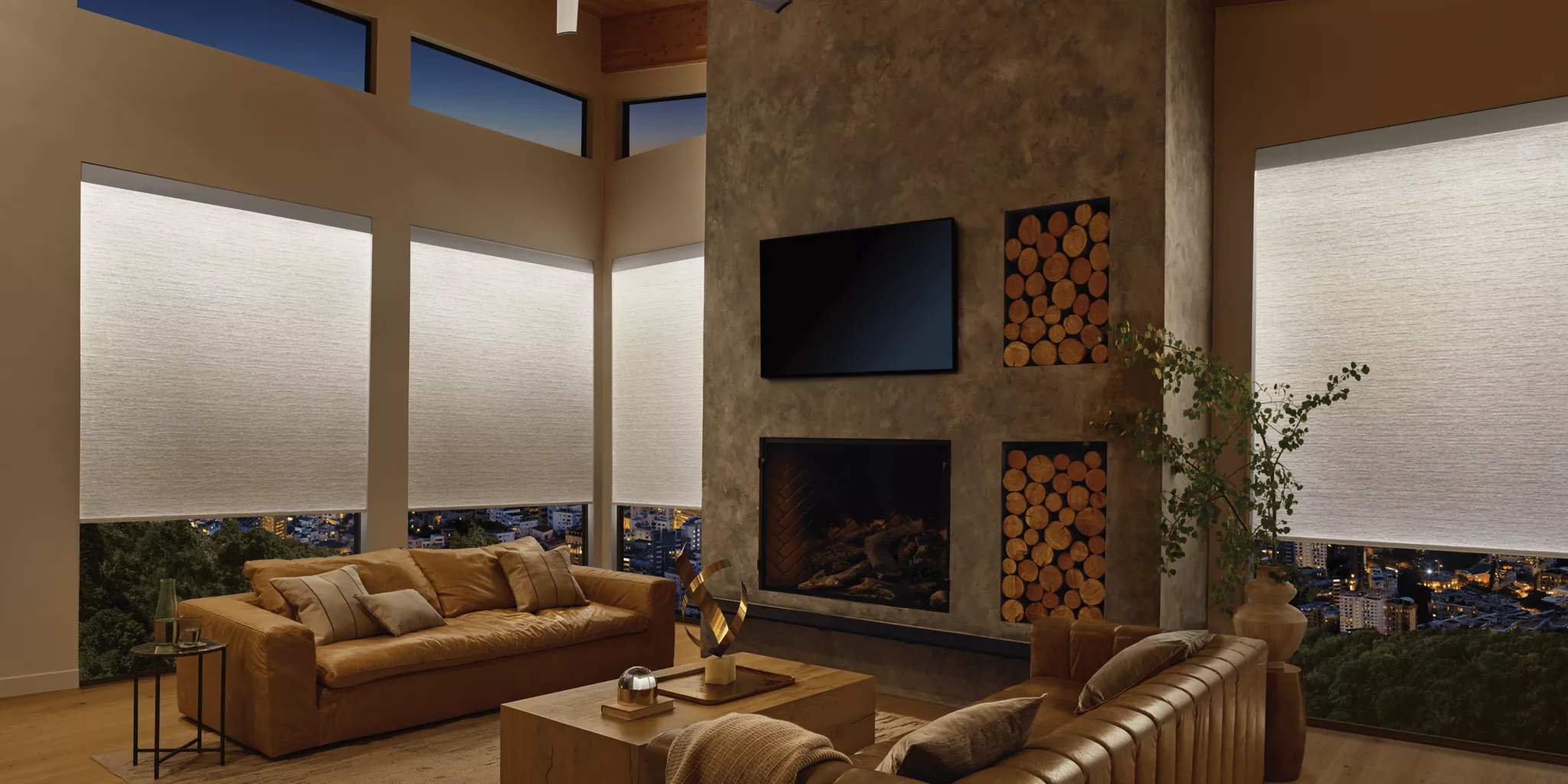In the realm of window treatments, the choices can seem endless, yet two contenders often steal the spotlight: blinds and shades. While these terms are sometimes used interchangeably, there are significant differences between them that cater to diverse preferences and needs. As a reputable window treatment retailer, The Blind, Shade & Shutter Co. recognizes the importance of understanding these nuances to guide customers towards the perfect solution for their homes. In this comprehensive guide, we embark on a journey to unravel the difference between blinds and shades, shedding light on their distinctions, functionalities, and stylistic potentials.
Understanding Blinds
Blinds, the stalwart of window adornments, are renowned for their versatility and timeless appeal. They consist of horizontal or vertical slats, often made from materials like wood, faux wood, aluminum, or vinyl. Let’s delve deeper into their characteristics:

Blinds Materials
- Wood Blinds: Exuding warmth and sophistication, wood blinds add a touch of natural elegance to any space. They are prized for their durability and timeless aesthetic, making them a popular choice for traditional and contemporary interiors alike.
- Faux Wood Blinds: Combining the charm of wood with enhanced durability, faux wood blinds are ideal for high-humidity areas like kitchens and bathrooms. They offer the look of real wood at a more budget-friendly price point, making them a practical option for many homeowners.
- Aluminum Blinds: Sleek, modern, and effortlessly chic, aluminum blinds are favored for their lightweight construction and easy maintenance. Available in a myriad of colors and finishes, they can seamlessly complement any decor style, from industrial to minimalist.
- Vinyl Blinds: Resilient, economical, and easy to clean, vinyl blinds are a popular choice for those seeking practicality without compromising on style. They are particularly well-suited for spaces prone to moisture and humidity, such as basements and laundry rooms.
Blinds Control Options
- Corded Blinds: Traditional corded blinds allow users to adjust the slats by pulling on a cord, offering precise control over light filtration and privacy levels.
- Cordless Blinds: For enhanced safety and a sleeker appearance, cordless blinds eliminate the need for cords, making them child and pet-friendly while also reducing clutter.
- Motorized Blinds: Embracing the convenience of modern technology, motorized blinds can be effortlessly operated with the touch of a button or a remote control, offering unparalleled ease and functionality.
Blinds Light Control and Privacy
- Tilt Mechanism: The tilt mechanism enables users to tilt the slats to their desired angle, allowing for precise control over the amount of sunlight entering the room while maintaining privacy.
- Room Darkening Options: Certain blinds are equipped with room darkening features, such as routeless slats or light-blocking materials, which are especially beneficial for bedrooms and media rooms where light control is paramount.
Understanding Shades
Shades, the epitome of understated elegance, offer a soft and streamlined alternative to blinds. Constructed from a single piece of fabric, they can be raised or lowered to adjust light levels and privacy. Let’s explore their distinctive attributes:

Shades Fabric Selection
- Roller Shades: Characterized by their clean lines and minimalist aesthetic, roller shades are available in a vast array of fabrics, ranging from sheer to blackout, allowing for customizable light filtration and privacy options.
- Roman Shades: Evoking timeless sophistication, roman shades feature soft folds of fabric that create an elegant drape when raised and a smooth, uncluttered appearance when lowered. They come in various styles, including flat, hobbled, and waterfall, to suit different design preferences.
- Cellular Shades: Also known as honeycomb shades, cellular shades boast a unique cellular construction that traps air within the pockets, providing enhanced insulation and energy efficiency. They are available in a range of opacities, from sheer to opaque, offering versatility in light control and privacy.
- Pleated Shades: With crisp pleats that add texture and dimension to any space, pleated shades strike a balance between style and functionality. They are lightweight, easy to operate, and come in a variety of colors and patterns to suit diverse tastes.
Shades Operating Systems
- Standard Cord Control: Traditional cord-operated shades allow users to raise and lower the shades by pulling on a cord, providing simple and reliable functionality.
- Cordless Lift: Cordless shades offer a safer and more streamlined alternative to corded shades, eliminating the risk of entanglement and providing a cleaner aesthetic.
- Continuous Cord Loop: Ideal for larger or heavier shades, the continuous cord loop mechanism allows for smooth and effortless operation, making it easier to raise and lower the shades with minimal effort.
Shades Light Filtering and Privacy
- Opacity Levels: Shades are available in varying opacity levels, ranging from sheer to blackout, allowing homeowners to choose the level of light filtration and privacy that best suits their needs.
- Top-Down/Bottom-Up: Certain shade styles, such as cellular and roman shades, offer the flexibility of top-down/bottom-up operation, allowing users to raise the shades from the bottom or lower them from the top, providing optimal control over light and privacy.
Choosing the Right Window Treatment
With a plethora of options available, selecting the perfect window treatment can seem daunting. However, by considering factors such as design preferences, functionality requirements, and budget constraints, homeowners can make informed decisions that enhance both the aesthetic and practical aspects of their living spaces.
- Design Aesthetic:
- Traditional: For classic elegance and timeless appeal, wood blinds or roman shades in rich fabrics and textures can add warmth and sophistication to traditional interiors.
- Modern: Sleek and minimalist, aluminum blinds or roller shades in clean lines and neutral tones can create a contemporary look that complements modern decor seamlessly.
- Transitional: Blending elements of traditional and contemporary styles, cellular shades or faux wood blinds offer versatility and flexibility, allowing homeowners to transition between different design aesthetics effortlessly.
- Functional Considerations:
- Light Control: Consider the orientation of the windows and the amount of natural light entering the room when selecting window treatments. Blinds offer precise control over light levels, while shades provide softer, diffused light.
- Privacy: Evaluate the level of privacy required for each room, taking into account factors such as proximity to neighbors and street traffic. Room darkening options and top-down/bottom-up operation can enhance privacy without sacrificing natural light.
- Budgetary Constraints:
- Blinds typically offer a more budget-friendly option compared to shades, making them an ideal choice for homeowners looking to achieve a stylish look without breaking the bank.
- However, shades can provide added value in terms of energy efficiency and insulation, potentially leading to long-term cost savings on heating and cooling bills.
In the realm of window treatments, blinds and shades stand as stalwart guardians of style and functionality, each offering a unique set of benefits to enhance the ambiance and comfort of any living space. As purveyors of quality window treatments, The Blind, Shade & Shutter Co. is committed to guiding customers through the intricacies of blinds and shades, empowering them to make informed decisions that transform their houses into homes. Whether seeking the timeless elegance of wood blinds or the understated sophistication of roman shades, homeowners can embark on a journey of discovery, unlocking the endless possibilities of window adornment.
Get in touch!
(703) 669-2400
[email protected]
52 W Colonial Hwy, Hamilton, VA 20158


Comments are closed